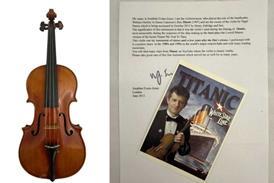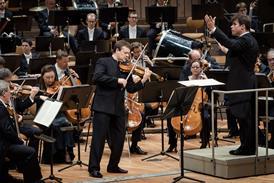In this extract from the August 2021 Masterclass, violist Antoine Tamestit guides us through the Austrian countryside through rustic dance and seamless legato

The following extract is from The Strad’s August issue Masterclass: Antoine Tamestit on Brahms Viola Sonata op.120 no.1 third and fourth movements. To read it in full, click here to subscribe and login. The August 2021 digital magazine and print edition are on sale now
A rustic, dancing third movement
The first note of the Allegretto grazioso is a continuation of the last note of the final, peaceful A of the Andante un poco adagio, but one dynamic level higher. We love to emphasise this by carrying that sweetness through into the piano opening bars. I think of the countryside when I play this, although it shouldn’t sound heavy or rough. It’s like a noble folk dance or ländler, with an Austrian, waltz-like swing to it, and it needs taste and refinement, with lightened second and third beats. It also needs a very good legato and a release at the end of each bar, without building in dynamics. That is a combination far easier to achieve on the clarinet than on the viola! Then, from the up-beat to bar 17, we can play with a more rustic feel, with full, engaging first beats, and a liberated, joyous sound. Now is the time to slap our thigh and have a beer!
It isn’t easy to make the exchange of voices between the viola and piano in bars 17–21 heard, so pianist Cédric Tiberghien and I swap our dynamics on the repeat, to help our listeners make the connection. Sometimes Cédric lets me come out clearly in bar 17 and then plays more in the bass in bar 19. At other times he brings out his right-hand theme more clearly. Just a small gesture is enough to indicate to each other what we want to do.
Finding a seamless legato
A passage that I find particularly beautiful and difficult is the grazioso e dolcissimo sempre from bar 33. This shows a real refinement to Brahms’s music that is not often seen. Again, it’s far easier to play on the clarinet, in one seamless, legato breath. On the viola, we have to practise creating a smooth effect without audible string-crossings or the sound of our fingers tapping on the fingerboard. This is especially difficult in bar 39, when we are all alone. I try to sing smoothly through the first two notes of each bar, staying in one position where possible, although I do slide up in the middle of bar 33. I also keep my right arm relaxed, with the elbow low and stable, only letting my hand adapt to the shape of the bridge and each string. That helps me to hide the string-crossings while phrasing every note and interval with expression. It’s not easy!
The trio and return to the theme
The whole trio, from bar 47, is difficult to approach because of all the syncopations in the piano. These should be understood as waves, rather than as distinct rhythmical units, so that we hardly know where the beats are. The repeated E flats in the viola part allude to the bell-like notes in the next movement, so I play them with resonance and without sustaining too much, as a premonition of what is to come.
I love the teneramente return to the theme in bar 90, because now we can play it even more tenderly than at the beginning. Cédric and I don’t take this too fast – perhaps at allegretto ma non troppo – so that we can play with more freedom, as if lost in memory. It is helpful to think of this place when choosing the tempo for the beginning of the movement, so that we allow enough room to play the theme a little more slowly when it returns. We start at crotchet = 138–144, then come down to around crotchet = 126–130 in bar 90. Any slower and we’d lose the swing and flow of the initial ländler. We pick up the tempo again from the up-beat to bar 107.
Read: Masterclass: Antoine Tamestit on Brahms Viola Sonata op.120 no.1 third and fourth movements
Read: Masterclass: Antoine Tamestit on Brahms Viola Sonata op.120 no.1 first and second movements
-
This article was published in the August 2021 Esther Yoo issue
The American violinist on competitions, collaborations and the importance of maintaining a positive outlook. Explore all the articles in this issue . Explore all the articles in this issue
More from this issue…
- American violinist Esther Yoo
- The benefits of an adjustable violin neck
- Bach’s Solo Violin Partitas
- The Herrmann bow making dynasty
- Female violinists in 18th-century England
- Making accurate arching templates
Read more playing content here
-

Masterclass: Antoine Tamestit on Brahms Viola Sonata op.120 no.1 third and fourth movements
- 1
- 2
 Currently reading
Currently reading‘I think of the countryside when I play this’ - Antoine Tamestit on the third movement of Brahms’ Viola Sonata op.120 no.1
- 3
- 4
- 5
- 6
- 7
- 8
- 9











































No comments yet